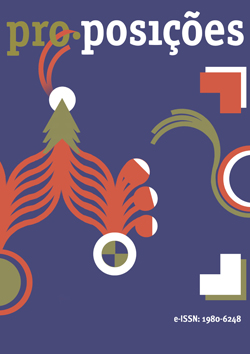Resumo
Este estudo verificou quais foram as estratégias de estimativa numérica de quantidades realizadas por crianças de uma escola pública e quais foram as mais frequentes e as mais precisas, a partir de entrevistas individuais semiestruturadas. Foram encontradas sete diferentes estratégias, que variavam de simples contagem exata até estratégias mais complexas, de estruturas multiplicativas. Os resultados indicaram que as crianças apresentaram maior frequência e precisão em estratégias de contagem exata para pequenas quantidades, mantendo a alta frequência, mas diminuindo a precisão no uso desta estratégia para grandes quantidades. Conclui-se que as crianças tendem a usar a contagem exata mesmo que isso não seja exigido e mesmo que não seja possível, sugerindo a importância de seu ensino na escola.
Referências
Crites, T. (1992). Skilled and Less Skilled Estimators’ Strategies for Estimating Discrete Quantities. Elementary School Journal, 5, 601–619.
Dehaene, S. (1997). The Number Sense: How the mind creates mathematics New York: Oxford University Press.
Dorneles, B., Duro, M., Santos, S., Pisacco, N., Sperafico, Y., & Enricone, J. (2015). Number Estimation in Children Assessed with a No-number-line Estimation Task In Biennial EARLI Conference, 16, Cyprus.
Gandini, D., Ardiale, E., & Lemaire, P. (2010). Children’ Strategies in Approximate Quantification. Current Psychology Letters: Behaviour, Brain, & Cognition, 26, 1-14.
Gil, A. (1999). Métodos e técnicas de pesquisa social, 5a ed. São Paulo: Atlas.
Huntley-Fenner, G. (2001). Children's Understanding of number is Similar to Adults' and Rats': numerical estimation by 5±7-year-olds. Cognition, 78, 27-40.
Zhao, J. & Yu, R. (2016). Statistical regularities reduce perceived numerosity. Cognition, 146, 217-222.
Lemaire, P. & Siegler, R. (1995). Four Aspects of Strategic Change: Contributions to Children’s Learning of Multiplication. Journal of Experimental Psychology: General, 124(1), 83-97.
Luwel, K., Beem, A., Onghena, P., & Verschaffel, L. (2001). Using Segmented Linear Regression Models with Unknown Change Points to Analyze Strategy Shifts in Cognitive Tasks. Behavior Research Methods, Instruments & Computers, 33(4), 470-478.
Luwel, K., Lemaire, P., & Verschaffel, L. (2005). Children’s strategies in numerosity judgment. Cognitive Development, 20, 448–471.
Luwel, K., Onghena, P., Torbeyns, J., Schillemans, V., & Verschaffel, L. (2009). Strengths and Weaknesses of the Choice/No-Choice Method in Research on Strategy Use. European Psychologist, 14(4), 351–362.
Luwel, K. & Verschaffel, L. (2003). Adapting Strategy Choices to Situational Factors: The effect of time pressure on children's numerosity judgement strategies. Psychologica Belgica.
Luwel, K., Verschaffel, L., Onghena, P., & Decorte, E. (2000). Children’s Strategies for Numerosity Judgment in Square Grids of Different Sizes. Psychologica Belgica, 40(3), 183-209.
Pincham, H. L. & Szucs, D. (2012). Intentional subitizing: Exploring the role of automaticity in enumeration. Cognition, 124, 107-116.
Revkin, S. K., Piazza, M., Izard, V., Cohen, L. & Dehaene, S. (2008). Does Subitizing Reflect Numerical Estimation? Psychological Science, 19(6), 607-614.
Sella, I., Berteletti, D., Lucangeli, & Zorzi M. (2017). Preschool children use space, rather than counting, to infer the numerical magnitude of digits: Evidence for a spatial mapping principle. Cognition, 158, 56-67.
Siegel, A., Goldsmith, T. & Madson, C. (1982). Skill in Estimation Problems of Extent and Numerosity. Journal for Research in Mathematics Education, 13, 211–232.
Siegler, R. S., & Booth, J. L. (2004). Development of Numerical Estimation in Young Children. Child Development, 75, 428-444.
Siegler, R., & Booth, J. (2005). Development of Numerical Estimation: A Review. In J. I. D. Campbell, Handbook of Mathematical Cognition Psychology Press: New York. Cap. 2, 197-212.
Siegler, R., & Lemaire, P. (1997). Older and Younger Adult’s Strategy Choices in Multiplication: Testing Predictions of ASCM Using the Choice/No-Choice Method. Journal of Experimental Psychology: General, 126(1), 71-92.
Smoothey, M. (1998). Atividades e jogos com estimativas São Paulo: Scipione.
Verschaffel, L., De Corte, E., Lamote, C., & Dhert, N. (1998). The Acquisition and Use of an Adaptive Strategy for Estimating Numerosity. European Journal of Psychology of Education, 13, 347-370.
Xu, F. (2003). Numerosity Discrimination in Infants: Evidence for two systems of representations. Cognition, 89, B15-B25.
Zimmermann, E. (2018). Small numbers are sensed directly, high numbers constructed from size and density. Cognition, 173, 1-7.

Este trabalho está licenciado sob uma licença Creative Commons Attribution 4.0 International License.
Copyright (c) 2021 Mariana Lima Duro, Beatriz Vargas Dorneles


